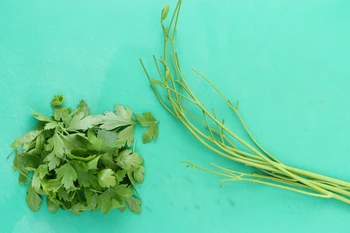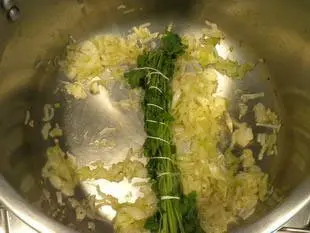This site uses only a few technical cookies necessary for its operation. By continuing to browse, you accept their use.
To find out more...
To find out more...
Parsley stems

Parsley, whether curly or flat, is a delicious ingredient in many recipes, where it is used both raw and cooked.
When used raw, in a salad for example, where it always provides, alone or with other herbs, a remarkable freshness, only the leaves are kept.
And when used cooked?
When used raw, in a salad for example, where it always provides, alone or with other herbs, a remarkable freshness, only the leaves are kept.
And when used cooked?
Last modified on: July 28th 2025
Parsley stems
Parsley, unlike chives, for example, can be used both raw and cooked, but when cooking, don't neglect the stems, also known as "tails".
It's not obvious at first glance, but much of parsley's flavour is in the stems, so it's a good idea to put them in your saucepan for cooking.
 Let's take a recipe for mussels marinière as an example: heat a base of dry white wine with onion and parsley, and open the mussels (I'm oversimplifying).
Let's take a recipe for mussels marinière as an example: heat a base of dry white wine with onion and parsley, and open the mussels (I'm oversimplifying).
Well, the big difference here is that the recipe uses the whole parsley, not just the leaves, because parsley tails are just as, if not more, important than the leaves when cooking. You can't eat them, but they add a lot to the taste, so you have to read "whole parsley sprigs (leaves + stems)" in the recipe, even if it says "parsley" in the list of ingredients, because it's very important for the recipe.
As they can't be eaten, it's a good idea to tie them with string into small bunches for easy removal at the end of cooking.
As a general rule, when a recipe calls for whole parsley, we often indicate "parsley sprig" instead of "parsley".
If you ever come across an old cookery book (before 1960/50, roughly speaking), you'll see that it's not uncommon to find recipes with "parsley tails" as an ingredient, mainly sauces in fact.
And parsley is one of the essential ingredients in the famous bouquet garni I've already told you about.
To sum up: for a recipe using cooked parsley, it's essential to use the whole sprig, leaves + stems.
It's not obvious at first glance, but much of parsley's flavour is in the stems, so it's a good idea to put them in your saucepan for cooking.
 Let's take a recipe for mussels marinière as an example: heat a base of dry white wine with onion and parsley, and open the mussels (I'm oversimplifying).
Let's take a recipe for mussels marinière as an example: heat a base of dry white wine with onion and parsley, and open the mussels (I'm oversimplifying).Well, the big difference here is that the recipe uses the whole parsley, not just the leaves, because parsley tails are just as, if not more, important than the leaves when cooking. You can't eat them, but they add a lot to the taste, so you have to read "whole parsley sprigs (leaves + stems)" in the recipe, even if it says "parsley" in the list of ingredients, because it's very important for the recipe.
As they can't be eaten, it's a good idea to tie them with string into small bunches for easy removal at the end of cooking.
As a general rule, when a recipe calls for whole parsley, we often indicate "parsley sprig" instead of "parsley".
If you ever come across an old cookery book (before 1960/50, roughly speaking), you'll see that it's not uncommon to find recipes with "parsley tails" as an ingredient, mainly sauces in fact.
And parsley is one of the essential ingredients in the famous bouquet garni I've already told you about.
To sum up: for a recipe using cooked parsley, it's essential to use the whole sprig, leaves + stems.
Lasts posts
Butter vs. grease
We often read in a recipe where a pastry is put into a mould that, just before pouring, the mould should be buttered or greased. But what's the difference between these 2 terms?December 1st 20259705
Getting out of the fridge early
Very often when you're cooking, you need to take food or preparations out of the fridge, to use them in the recipe in progress. There's nothing tricky about this: you just take them out of the fridge and use them, usually immediately, in the recipe. But is this really a good method?November 24th 20251,1045
Who's making the croissants?
When you look at a bakery from the outside, you naturally think that in the bakery, the bakers make the bread, and in the laboratory, the pastry chefs make the cakes. It's very often like that, with each of these professions having quite different ways of working, but sometimes there's also one...November 23th 2025998
Oven height
When we put a dish or cake in the oven, we naturally tend to put it on the middle shelf, and that's what we usually do. But in some cases, this position and height can be a little tricky, so let's find out why.October 8th 20252,7265
The importance of sieving
In recipes that use a fine powder (flour, powdered sugar, etc.), you'll often see the advice to sift before using it. To sift is to pass the powder in question through a sieve (a very fine strainer) before incorporating it into your recipe. It's often advice, but is it really useful?September 3rd 20257,5273
Other pages you may also like
The return of the "Norman hole"
You maybe know the "trou normand", this old gastronomic custom typically French which consists in taking a (small) glass of calvados, generally between the last course and the dessert? It's something that seems a bit anachronistic nowadays, having a glass of an alcohol of more than 60° in the...December 18th 202115 K4.8
Perpetual stock
It's something you have probably have done yourself: cooked or pre-cooked vegetables before adding them to a recipe. This is almost always done the same way: peel the chosen vegetables (carrots, for example), cut them up, boil them in salted water (using a tablespoon or so of coarse salt per litre),...November 22th 201631 K5
Tranché, dissociated, failed, in short... missed!
When preparing a sauce or a cream, there's always a (small) risk that the creamy preparation you're working on will suddenly separate into two parts of different textures: a liquid part, for example, and a more or less solid part, or even become lumpy. It's terribly frustrating, but we'll see...June 19th 202313 K5
No need to boil gelatin
Gelatin is a magical ingredient for making light, creamy, structured desserts, yet it's often misused in the kitchen. A common mistake in some recipes is the idea that it needs to be boiled for it to work properly, but this is a mistake indeed: gelatin melts at a much lower temperature, around...November 21th 20248,2655
A few tips for effective kneading at home
When you have to knead dough for bread or some other recipe, you may well use a food processor or the type of machine known as a stand mixer. The best-known brands are Kenwood and KitchenAid. They are useful tools, but here are a few tips to help you get the best out of them.June 23th 2021284 K 23.8
Follow this page
If you are interested in this page, you can "follow" it, by entering your email address here. You will then receive a notification immediately each time the page is modified or a new comment is added. Please note that you will need to confirm this following.
Note: We'll never share your e-mail address with anyone else.
Alternatively: you can subscribe to the mailing list of cooling-ez.com , you will receive a e-mail for each new recipe published on the site.










The 1 comment already posted on this page
Thank you.